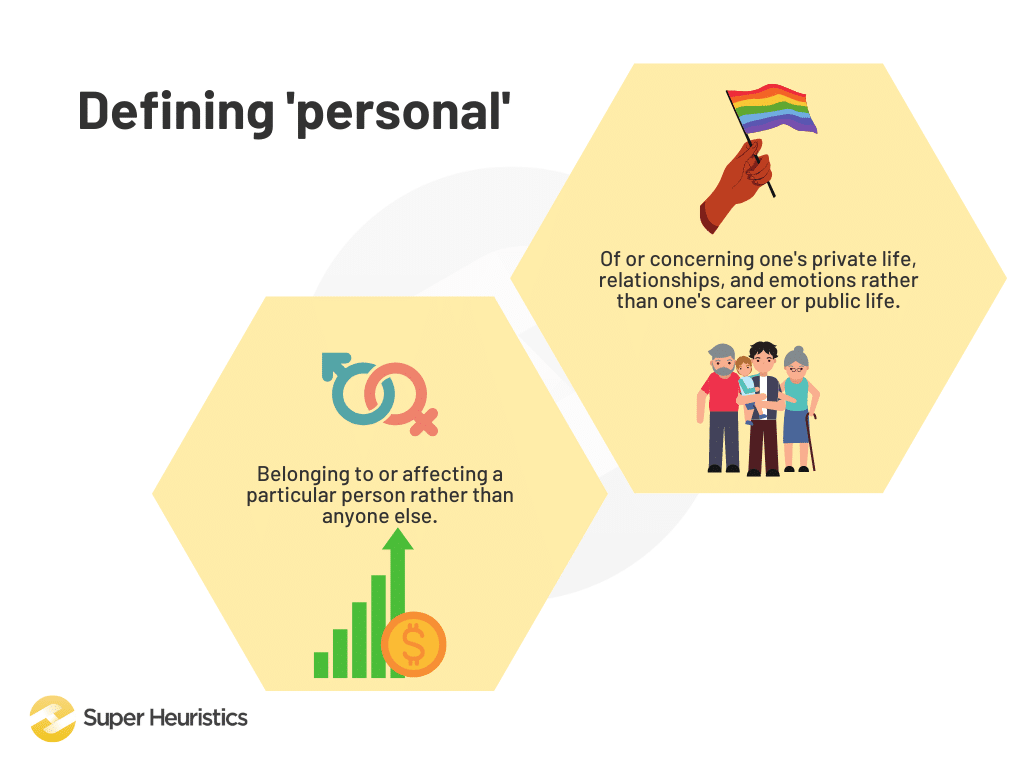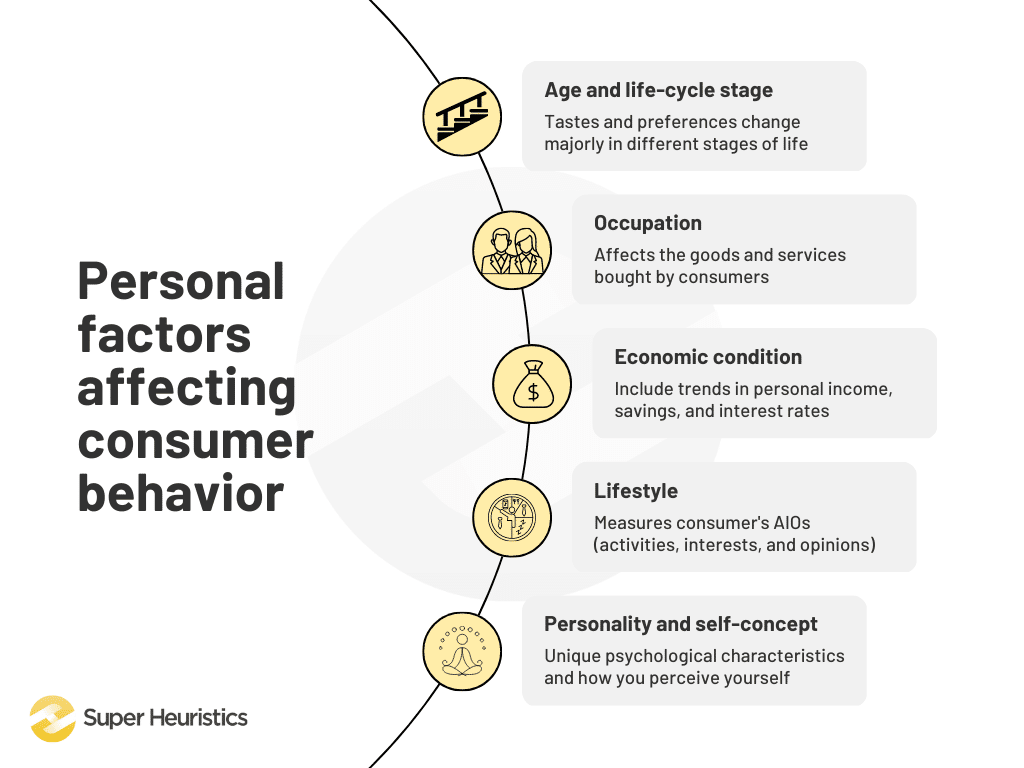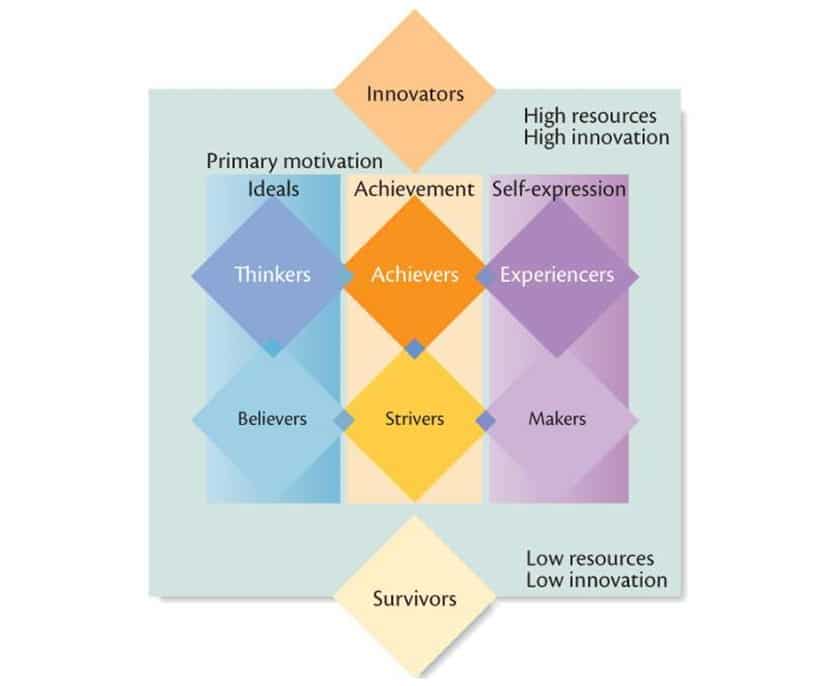When marketers study their target markets, they make sure to understand that each consumer has some personal factors affecting their consumer behavior in addition to social and cultural factors. But what does this mean?
Let’s continue with the instant noodles example we started our journey in consumer behavior with in Chapter 1. Like all other brands, your favorite instant noodles brand considers the key demographics of its target market. This demographic includes personal factors such as your age and income.
The brand carefully studies how the personal factors affecting consumer behavior change patterns across demographic groups. After careful consideration and deliberation, the brand finalizes its products' target market. Even then, it has to continuously study the five personal factors affecting consumers to stay on top of its game.
But what are these personal factors affecting consumer behavior? How do these affect your marketing decisions? Most importantly, how does studying these factors give you an advantage over other marketers in your field?
After reading this chapter, you will know the answers to all these questions. Let’s get started!
Understanding what marketers mean by “personal”
Since we are studying the personal factors in consumer behavior, it is crucial that you understand what falls under the purview of ‘personal.’
The Oxford Dictionary gives us two definitions of ‘personal’:
- “belonging to or affecting a particular person rather than anyone else.”
- “of or concerning one's private life, relationships, and emotions rather than one's career or public life.”

We can clearly see that ‘personal’ changes from individual to individual. This includes one’s age, gender, sexuality, income, preferences, etc.
To a certain extent, it also includes personal consumer behavior because even though many other factors influence your consumer behavior, the final decision of buying or not buying, liking or not liking, and repeating or not repeating a product or service is in your own hands.
Even if your friends like another instant noodles brand or your cultural group find your favorite instant noodles distasteful, at the end of the day, it is you who you are looking out for. With your purchase decisions, you are trying to satisfy your own needs.
You are now ready to delve deeper into the world of personal influence in consumer behavior. Let us take a look at the five personal factors affecting consumer behavior.
Understanding the personal factors affecting consumer behavior
In all, there are five personal factors affecting consumers. We will look at all of these factors in detail, along with how they affect the marketing decisions of your favorite instant noodles brand. This will allow you to understand the importance of studying the personal factors affecting consumer behavior.

1. Age and life-cycle stage
You must agree with me when I say that your choices and patterns of consumer behavior were different when you were younger as compared to now. Even if you consume some of the same products as you did when you were a child, your tastes and preferences are sure to have changed over the years.
For example, your spice tolerance as a kid might have been lower than your spice tolerance now. So you might have switched to a different instant noodles brand now or a different product from the same brand.
Philip Kotler prescribes the five stages of life as identified by the Royal Bank of Canada (RBC). These are
- Youth - younger than 18 years
- Getting started - 18 to 35 years
- Builders - 35 to 50 years
- Accumulators - 50 to 60 years
- Preservers - over 60 years
Consumer behavior patterns across these five stages vary vastly.
During your youth, you are likely to have preferences similar to your parents since you live with them and observe them closely. In this stage, you were likely to consume instant noodles very rarely, and the brand would have been the one your parents preferred.
During the ‘getting started’ stage of life, you will get a higher education, start a family, and settle down. In this phase, you are likely to experiment more and try new things till you find the ones that best satisfy your needs.
For example, it is possible that your favorite instant noodles brand is the one that you picked from the shelf randomly one day!
Builders are likely to invest more in their children than themselves, thus adapting themselves to their children’s preferences rather than their own.
Accumulators try to save money for their retirement period.
Preservers are focused almost solely on health and related services.
Your favorite instant noodles brand is very likely to target the getting started segment because college students are the largest segment of instant noodles consumers across the world due to the ease of availability, price range, and ease of consumption. Moreover, this is the segment that will introduce their kids to instant noodles, and if the parents prefer their brand, they are more likely to have a stock in their pantries.
2. Occupation
The Oxford Dictionary defines occupation as “a job or profession.”
So your current occupation is being a student as you are investing your time in learning marketing. Philip Kotler rightly said that occupation affects the goods and services bought by consumers.
Occupation influences consumer behavior because approximately one-third of the day is spent at the workplace. Apart from spending time with colleagues, the position one’s in also impacts consumer behavior.
For example, if you work as a senior manager in a consultancy firm, you are likely to dress up in elegant branded clothes that look like they cost a fortune. You are also likely to prefer expensive watches over cheaper rip-offs.
Your favorite instant noodles brand is likely to target college-going students staying in hostels and PGs because they do not have the utensils and means to cook more expensive meals.
3. Economic condition
According to Philip Kotler, economic conditions include trends in personal income, savings, and interest rates.
Consumers are not only getting more price-conscious but also more value-conscious. They are only willing to pay for what they expect they are getting from the product or service.
Companies are now focusing on making consumers believe that they are paying less but getting more - more satisfaction and utility.
The personal income of a person is the sum total of their salary, rent received, and other compensation from outside the household. Out of this personal income, every consumer sets aside some portion as savings for future purchases or emergencies.
Interest rates include the interest paid on loans and interest received on deposits. If the former is high, consumers are likely to borrow less and vice-versa. If the latter is high, consumers are likely to deposit more and vice-versa.
All three of these components together determine the economic condition of a consumer. Based on this, the consumer is expected to shape their consumer behavior and buying decisions. This is perhaps the most predictable personal factor affecting consumer behavior.
Since your favorite instant noodles brand is targeting college students, it knows that the price range has to be quite low. However, since college students have good knowledge about utility, it also takes good care to remind you about how much satisfaction it provides you.
4. Lifestyle
Philip Kotler defines lifestyle as “a person’s pattern of living as expressed in his or her psychographics.”
It measures a consumer’s AIOs (activities, interests, and opinions) to capture information about a person’s pattern of acting and interacting in the environment. It considers patterns of all the interactions and actions a consumer has with the world.
Consumers are value-focused now. They don’t purchase any random product but analyze the value and lifestyle a brand depicts and represents. Marketers like you can study the lifestyle of your target market to understand the change in trends and values.
SRI Consulting has given a VALS (values and lifestyles) typology that classifies consumers according to how they spend their time and money based on their primary motivations and resources. Primary motivations include ideals, achievements, and self-expression. Resources can either be high or low.
The SRI Consulting’s VALS typology is given below.

To better understand the VALS typology, head over to this wonderfully written piece.
College students best fall under the category of ‘believers.’ They have low resources (money) and believe in word of mouth (of friends). This is an easy target market for your favorite instant noodles brand because if one person in a friend circle enjoys its products, it is likely that they will convince others in the group to give it a shot too.
5. Personality and self-concept
According to Philip Kotler, personality refers to the unique psychological characteristics that lead to consistent and lasting responses to the consumer’s environment.
Some general personality traits include self-confidence, sociability, autonomy, aggressiveness, etc. There are a number of personality tests available online (both free and paid) to determine the type of personality you have.
Kotler says that brand personality refers to the specific mix of human traits that may be attributed to a particular brand:
Sincerity
Excitement
Competence
Sophistication
Ruggedness
Both an individual’s personality and the brand’s personality affect how the consumer perceives the brand and ultimately interacts with it. If the consumer and the brand have a similar personality, the consumer is very likely to purchase its products and services and repeat them.
If the brand represents something the consumer is neutral about, the consumer may or may not be willing to try its products. But if the consumer and the brand have opposing personalities, the consumer is likely to never interact with the brand at all.
As per Philip Kotler, self-concept refers to people’s possessions that contribute to and reflect their identities.
In simpler words, self-concept is how you look at or perceive how you behave in the market and yourself.
More than the actual personality, self-concept has a bigger role to play in defining one’s consumer behavior because we behave the way we perceive ourselves, which is ultimately the way we want others to perceive us.
So, if you think of yourself as someone who goes with the flow, you are likely to bring back a new brand of instant noodles from the supermarket each time you go shopping. If you want to be perceived as someone who plays it safe, you will buy your favorite brand of instant noodles to display your loyalty.
Understanding all personal five factors together
To unite all the personal factors affecting consumer behavior, let us take one final example with the bigger picture in mind.
Imagine that in the near future, after topping your class, you get your dream job as the marketer at your favorite instant noodles brand! You want to switch things up by targeting the youth segment of the market along with the getting started segment.
To pitch the idea to your boss, you need to make sure that you do not come across as someone who doesn’t know what they are talking about. So you do your research and study the personal factors affecting consumer behavior in depth.
You conclude that most of the youth (age and life-cycle stage) is made up of students (occupation) who depend on their parents for even their basic needs (economic conditions). Even though they do not have any resources, they do want to show off to their peers (lifestyle), which places them in the same VALS typology as the getting-started college students - believers.
The youth’s self-concept includes the thought that they are independent thinkers. They want to lead a posh life without a care in the world (personality and self-concept). This will lead them to ask their parents for the instant noodles brand they best connect with through advertisements. Because they are stubborn, they are likely to ask for repeat purchases, even if they don’t like the taste. They also want to fit it, so once the trend is set, your brand is all ready to go!
However, one problem still remains. How do you convince the parents to listen to their kids? Advertise the health benefits! Don’t only go for things that attract toddlers and teens but also aim to advertise why the parents should buy your instant noodles.
Confidently, you walk to your boss’s office and pitch your idea. The boss accepts it because you have done your homework and researched the personal factors affecting consumer behavior of kids effectively. Maybe you even get a raise!
The reason your boss accepted your pitch as the need of the hour was that you appealed to each proposed target segment’s personal factors. You did not just rely on baseless assumptions or unrelated facts and figures to persuade your boss.
Conclusion & key takeaways
With this, we come to the end of Chapter 5 in the consumer behavior series. To recap, here are the key takeaways:
- ‘Personal’ changes from individual to individual. This includes one’s age, gender, sexuality, income, preferences, etc.
- There are five stages of life as prescribed by Philip Kotler. These are youth (younger than 18 years), getting started (18 to 35 years), builders (35 to 50 years), accumulators (50 to 60 years), and preservers (over 60 years).
- The Oxford Dictionary defines occupation as “a job or profession.” Occupation influences consumer behavior because approximately one-third of the day is spent at the workplace. Apart from spending time with colleagues, the position one’s in also impacts consumer behavior.
- According to Philip Kotler, economic conditions include trends in personal income, savings, and interest rates.
- Philip Kotler defines lifestyle as “a person’s pattern of living as expressed in his or her psychographics.” SRI Consulting has given a VALS (values and lifestyles) typology that classifies consumers according to how they spend their time and money based on their primary motivations and resources.
- According to Philip Kotler, personality refers to the unique psychological characteristics that lead to consistent and lasting responses to the consumer’s environment. As per Philip Kotler, self-concept refers to people’s possessions that contribute to and reflect their identities.
In the next chapter, we will study the psychological factors affecting consumer behavior.

